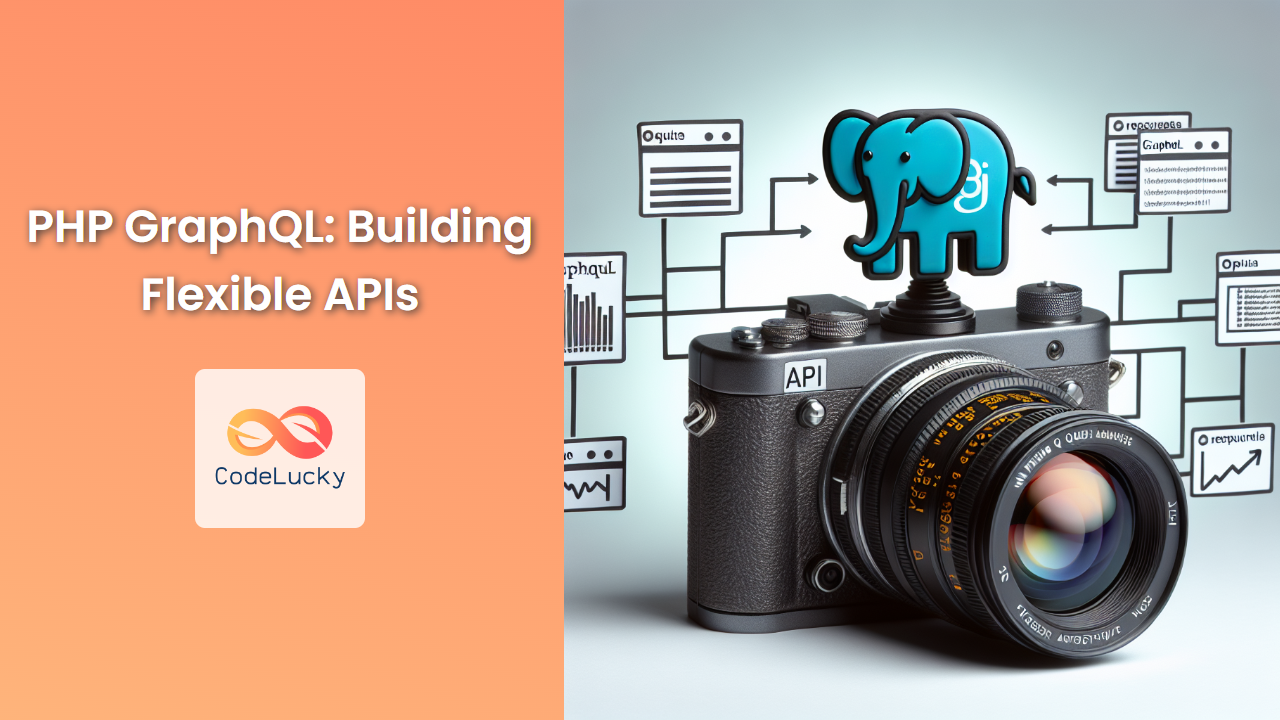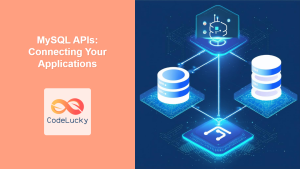In the ever-evolving landscape of web development, APIs play a crucial role in connecting different systems and enabling seamless data exchange. While REST APIs have been the go-to choice for many years, GraphQL has emerged as a powerful alternative, offering more flexibility and efficiency. In this article, we'll dive deep into the world of PHP GraphQL and learn how to build flexible APIs that can revolutionize your web applications.
What is GraphQL?
GraphQL is a query language and runtime for APIs that was developed by Facebook in 2012 and open-sourced in 2015. Unlike traditional REST APIs, GraphQL allows clients to request exactly the data they need, nothing more and nothing less. This approach offers several advantages:
- 🚀 Reduced over-fetching and under-fetching of data
- 🔄 Fewer API calls required to fetch related data
- 📊 Strong typing and introspection capabilities
- 🛠️ Easier evolution of APIs without versioning
Setting Up a PHP GraphQL Server
To get started with GraphQL in PHP, we'll use the popular webonyx/graphql-php library. First, let's set up our project:
mkdir php-graphql-demo
cd php-graphql-demo
composer require webonyx/graphql-php
Now, let's create a simple GraphQL schema and server. We'll build an API for a bookstore application.
Create a file named index.php and add the following code:
<?php
require_once 'vendor/autoload.php';
use GraphQL\Type\Definition\ObjectType;
use GraphQL\Type\Definition\Type;
use GraphQL\Type\Schema;
use GraphQL\GraphQL;
// Define the Book type
$bookType = new ObjectType([
'name' => 'Book',
'fields' => [
'id' => Type::int(),
'title' => Type::string(),
'author' => Type::string(),
'price' => Type::float(),
]
]);
// Define the Query type
$queryType = new ObjectType([
'name' => 'Query',
'fields' => [
'book' => [
'type' => $bookType,
'args' => [
'id' => Type::nonNull(Type::int())
],
'resolve' => function ($root, $args) {
// In a real application, you would fetch this from a database
$books = [
1 => ['id' => 1, 'title' => 'The Great Gatsby', 'author' => 'F. Scott Fitzgerald', 'price' => 12.99],
2 => ['id' => 2, 'title' => '1984', 'author' => 'George Orwell', 'price' => 10.99],
];
return $books[$args['id']] ?? null;
}
],
'books' => [
'type' => Type::listOf($bookType),
'resolve' => function () {
// In a real application, you would fetch this from a database
return [
['id' => 1, 'title' => 'The Great Gatsby', 'author' => 'F. Scott Fitzgerald', 'price' => 12.99],
['id' => 2, 'title' => '1984', 'author' => 'George Orwell', 'price' => 10.99],
];
}
]
]
]);
// Create the schema
$schema = new Schema([
'query' => $queryType
]);
// Handle the request
$rawInput = file_get_contents('php://input');
$input = json_decode($rawInput, true);
$query = $input['query'];
$variableValues = isset($input['variables']) ? $input['variables'] : null;
try {
$result = GraphQL::executeQuery($schema, $query, null, null, $variableValues);
$output = $result->toArray();
} catch (\Exception $e) {
$output = [
'errors' => [
[
'message' => $e->getMessage()
]
]
];
}
header('Content-Type: application/json');
echo json_encode($output);
Let's break down this code and understand what's happening:
- We define a
Booktype with fields likeid,title,author, andprice. - We create a
Querytype with two fields:book(to fetch a single book by ID) andbooks(to fetch all books). - We set up a schema using these types.
- We handle the incoming GraphQL request, execute the query, and return the result as JSON.
Testing Our GraphQL API
To test our API, we can use tools like cURL or Postman. Let's try a few queries:
- Fetching all books:
curl -X POST -H "Content-Type: application/json" -d '{"query": "{ books { id title author price } }"}' http://localhost:8000
This should return:
{
"data": {
"books": [
{
"id": 1,
"title": "The Great Gatsby",
"author": "F. Scott Fitzgerald",
"price": 12.99
},
{
"id": 2,
"title": "1984",
"author": "George Orwell",
"price": 10.99
}
]
}
}
- Fetching a single book:
curl -X POST -H "Content-Type: application/json" -d '{"query": "{ book(id: 1) { title author } }"}' http://localhost:8000
This should return:
{
"data": {
"book": {
"title": "The Great Gatsby",
"author": "F. Scott Fitzgerald"
}
}
}
Notice how we can request only the fields we need. This is one of the key advantages of GraphQL!
Adding Mutations
So far, we've only implemented queries to fetch data. Let's add a mutation to create a new book:
Update your index.php file with the following additions:
// ... (previous code remains the same)
// Define the Mutation type
$mutationType = new ObjectType([
'name' => 'Mutation',
'fields' => [
'createBook' => [
'type' => $bookType,
'args' => [
'title' => Type::nonNull(Type::string()),
'author' => Type::nonNull(Type::string()),
'price' => Type::nonNull(Type::float())
],
'resolve' => function ($root, $args) {
// In a real application, you would save this to a database
$newBook = [
'id' => 3, // This would typically be generated by the database
'title' => $args['title'],
'author' => $args['author'],
'price' => $args['price']
];
return $newBook;
}
]
]
]);
// Update the schema to include mutations
$schema = new Schema([
'query' => $queryType,
'mutation' => $mutationType
]);
// ... (rest of the code remains the same)
Now we can create a new book using a mutation:
curl -X POST -H "Content-Type: application/json" -d '{"query": "mutation { createBook(title: \"To Kill a Mockingbird\", author: \"Harper Lee\", price: 14.99) { id title author price } }"}' http://localhost:8000
This should return:
{
"data": {
"createBook": {
"id": 3,
"title": "To Kill a Mockingbird",
"author": "Harper Lee",
"price": 14.99
}
}
}
Implementing Data Loaders
One common issue with GraphQL is the N+1 query problem. This occurs when you fetch a list of items and then need to fetch related data for each item. To solve this, we can use data loaders.
Let's implement a simple data loader for our books:
<?php
require_once 'vendor/autoload.php';
use GraphQL\Type\Definition\ObjectType;
use GraphQL\Type\Definition\Type;
use GraphQL\Type\Schema;
use GraphQL\GraphQL;
use GraphQL\Deferred;
class BookLoader
{
private $books = [
1 => ['id' => 1, 'title' => 'The Great Gatsby', 'author' => 'F. Scott Fitzgerald', 'price' => 12.99],
2 => ['id' => 2, 'title' => '1984', 'author' => 'George Orwell', 'price' => 10.99],
];
private $load_calls = 0;
public function load($id)
{
return new Deferred(function () use ($id) {
$this->load_calls++;
return $this->books[$id] ?? null;
});
}
public function loadMany($ids)
{
return array_map([$this, 'load'], $ids);
}
public function getLoadCalls()
{
return $this->load_calls;
}
}
$bookLoader = new BookLoader();
$bookType = new ObjectType([
'name' => 'Book',
'fields' => [
'id' => Type::int(),
'title' => Type::string(),
'author' => Type::string(),
'price' => Type::float(),
]
]);
$queryType = new ObjectType([
'name' => 'Query',
'fields' => [
'book' => [
'type' => $bookType,
'args' => [
'id' => Type::nonNull(Type::int())
],
'resolve' => function ($root, $args) use ($bookLoader) {
return $bookLoader->load($args['id']);
}
],
'books' => [
'type' => Type::listOf($bookType),
'resolve' => function () use ($bookLoader) {
return $bookLoader->loadMany([1, 2]);
}
],
'loadCalls' => [
'type' => Type::int(),
'resolve' => function () use ($bookLoader) {
return $bookLoader->getLoadCalls();
}
]
]
]);
$schema = new Schema([
'query' => $queryType
]);
$rawInput = file_get_contents('php://input');
$input = json_decode($rawInput, true);
$query = $input['query'];
$variableValues = isset($input['variables']) ? $input['variables'] : null;
try {
$result = GraphQL::executeQuery($schema, $query, null, null, $variableValues);
$output = $result->toArray();
} catch (\Exception $e) {
$output = [
'errors' => [
[
'message' => $e->getMessage()
]
]
];
}
header('Content-Type: application/json');
echo json_encode($output);
In this updated version:
- We've created a
BookLoaderclass that simulates loading books from a data source. - The
loadmethod returns aDeferredobject, which allows GraphQL to batch multiple requests together. - We've added a
loadCallsfield to demonstrate how many times the loader is actually called.
Now, let's test our optimized API:
curl -X POST -H "Content-Type: application/json" -d '{"query": "{ books { id title author } loadCalls }"}' http://localhost:8000
This should return:
{
"data": {
"books": [
{
"id": 1,
"title": "The Great Gatsby",
"author": "F. Scott Fitzgerald"
},
{
"id": 2,
"title": "1984",
"author": "George Orwell"
}
],
"loadCalls": 1
}
}
Notice that even though we're fetching two books, loadCalls is only 1. This demonstrates that our data loader is efficiently batching requests!
Implementing Interfaces and Union Types
GraphQL allows us to define interfaces and union types, which can be useful for creating more flexible and extensible schemas. Let's extend our bookstore example to include different types of products:
<?php
require_once 'vendor/autoload.php';
use GraphQL\Type\Definition\ObjectType;
use GraphQL\Type\Definition\InterfaceType;
use GraphQL\Type\Definition\UnionType;
use GraphQL\Type\Definition\Type;
use GraphQL\Type\Schema;
use GraphQL\GraphQL;
// Define the Product interface
$productInterface = new InterfaceType([
'name' => 'Product',
'fields' => [
'id' => Type::nonNull(Type::int()),
'name' => Type::nonNull(Type::string()),
'price' => Type::nonNull(Type::float()),
],
'resolveType' => function ($value) {
if (isset($value['author'])) {
return 'Book';
}
if (isset($value['artist'])) {
return 'Album';
}
return null;
}
]);
// Define the Book type
$bookType = new ObjectType([
'name' => 'Book',
'interfaces' => [$productInterface],
'fields' => [
'id' => Type::nonNull(Type::int()),
'name' => Type::nonNull(Type::string()),
'price' => Type::nonNull(Type::float()),
'author' => Type::nonNull(Type::string()),
'pages' => Type::int(),
]
]);
// Define the Album type
$albumType = new ObjectType([
'name' => 'Album',
'interfaces' => [$productInterface],
'fields' => [
'id' => Type::nonNull(Type::int()),
'name' => Type::nonNull(Type::string()),
'price' => Type::nonNull(Type::float()),
'artist' => Type::nonNull(Type::string()),
'tracks' => Type::int(),
]
]);
// Define a union type for search results
$searchResultUnion = new UnionType([
'name' => 'SearchResult',
'types' => [$bookType, $albumType],
'resolveType' => function ($value) {
if (isset($value['author'])) {
return 'Book';
}
if (isset($value['artist'])) {
return 'Album';
}
return null;
}
]);
// Define the Query type
$queryType = new ObjectType([
'name' => 'Query',
'fields' => [
'product' => [
'type' => $productInterface,
'args' => [
'id' => Type::nonNull(Type::int())
],
'resolve' => function ($root, $args) {
$products = [
1 => ['id' => 1, 'name' => 'The Great Gatsby', 'price' => 12.99, 'author' => 'F. Scott Fitzgerald', 'pages' => 180],
2 => ['id' => 2, 'name' => 'Thriller', 'price' => 9.99, 'artist' => 'Michael Jackson', 'tracks' => 9],
];
return $products[$args['id']] ?? null;
}
],
'search' => [
'type' => Type::listOf($searchResultUnion),
'args' => [
'query' => Type::nonNull(Type::string())
],
'resolve' => function ($root, $args) {
$products = [
['id' => 1, 'name' => 'The Great Gatsby', 'price' => 12.99, 'author' => 'F. Scott Fitzgerald', 'pages' => 180],
['id' => 2, 'name' => 'Thriller', 'price' => 9.99, 'artist' => 'Michael Jackson', 'tracks' => 9],
];
return array_filter($products, function ($product) use ($args) {
return stripos($product['name'], $args['query']) !== false;
});
}
]
]
]);
// Create the schema
$schema = new Schema([
'query' => $queryType,
'types' => [$bookType, $albumType]
]);
// Handle the request
$rawInput = file_get_contents('php://input');
$input = json_decode($rawInput, true);
$query = $input['query'];
$variableValues = isset($input['variables']) ? $input['variables'] : null;
try {
$result = GraphQL::executeQuery($schema, $query, null, null, $variableValues);
$output = $result->toArray();
} catch (\Exception $e) {
$output = [
'errors' => [
[
'message' => $e->getMessage()
]
]
];
}
header('Content-Type: application/json');
echo json_encode($output);
In this extended example:
- We've defined a
Productinterface that bothBookandAlbumtypes implement. - We've created a
SearchResultunion type that can return either aBookor anAlbum. - We've updated our query type to include a
productfield that returns aProductinterface and asearchfield that returns a list ofSearchResultunion types.
Now let's test our new schema with some queries:
- Fetching a product (book):
curl -X POST -H "Content-Type: application/json" -d '{"query": "{ product(id: 1) { id name price ... on Book { author pages } } }"}' http://localhost:8000
This should return:
{
"data": {
"product": {
"id": 1,
"name": "The Great Gatsby",
"price": 12.99,
"author": "F. Scott Fitzgerald",
"pages": 180
}
}
}
- Searching for products:
curl -X POST -H "Content-Type: application/json" -d '{"query": "{ search(query: \"t\") { __typename ... on Book { name author } ... on Album { name artist } } }"}' http://localhost:8000
This should return:
{
"data": {
"search": [
{
"__typename": "Book",
"name": "The Great Gatsby",
"author": "F. Scott Fitzgerald"
},
{
"__typename": "Album",
"name": "Thriller",
"artist": "Michael Jackson"
}
]
}
}
Conclusion
In this comprehensive guide, we've explored how to build flexible APIs using PHP and GraphQL. We've covered:
- 🏗️ Setting up a basic GraphQL server
- 🔍 Implementing queries and mutations
- 🚀 Optimizing performance with data loaders
- 🔗 Using interfaces and union types for more flexible schemas
GraphQL offers a powerful way to build APIs that are both flexible for clients and efficient for servers. By allowing clients to request exactly the data they need, GraphQL can significantly reduce over-fetching and under-fetching of data, leading to more efficient applications.
As you continue to explore GraphQL with PHP, consider diving into more advanced topics such as:
- 🔐 Authentication and authorization
- 📊 Pagination
- 🔄 Real-time updates with subscriptions
- 🧪 Testing GraphQL APIs
Remember, while GraphQL offers many advantages, it's not always the best solution for every project. Consider your specific requirements and constraints when choosing between GraphQL and other API architectures like REST.
Happy coding, and may your APIs be ever flexible and efficient! 🚀👨💻👩💻



















